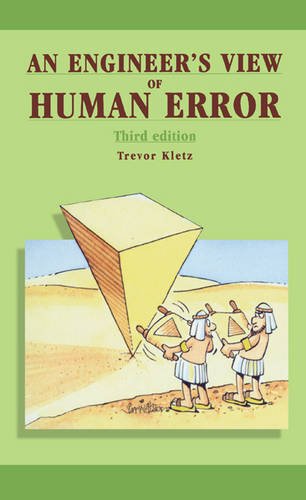

Most ebook files are in PDF format, so you can easily read them using various software such as Foxit Reader or directly on the Google Chrome browser.
Some ebook files are released by publishers in other formats such as .awz, .mobi, .epub, .fb2, etc. You may need to install specific software to read these formats on mobile/PC, such as Calibre.
Please read the tutorial at this link. https://ebooknice.com/page/post?id=faq
We offer FREE conversion to the popular formats you request; however, this may take some time. Therefore, right after payment, please email us, and we will try to provide the service as quickly as possible.
For some exceptional file formats or broken links (if any), please refrain from opening any disputes. Instead, email us first, and we will try to assist within a maximum of 6 hours.
EbookNice Team

Status:
Available4.5
35 reviews
ISBN 10: 1560329106
ISBN 13: 9781560329107
Author: Trevor Kletz
This title looks at how people, as opposed to technology and computers, are arguably the most unreliable factor within plants, leading to dangerous situations.
1 Introduction
1.1 Accept men as we find them
1.2 Meccano or dolls?
1.3 Types of human error
1.4 Two simple examples
1.5 Accident investigation
1.6 A story
1.7 Research on human error
2 Accidents caused by simple slips
2.1 Introduction
2.2 Forgetting to open or close a valve
2.3 Operating the wrong valve
2.4 Pressing the wrong button
2.5 Failures to notice
2.6 Wrong connections
2.7 Errors in calculations
2.8 Other medical errors
2.9 Railways
2.10 Other industries
2.11 Everyday life (and typing)
2.12 Fatigue
3 Accidents that could be prevented by better training or instructions
3.1 Introduction
3.2 Three Mile Island
3.3 Other accidents that could be prevented by relatively sophisticated training
3.4 Accidents that could be prevented by elementary training
3.5 Contradictory instructions
3.6 Knowledge of what we don’t know
3.7 Some simple ways of improving instructions
3.8 Training or instructions?
3.9 Cases when training is not the best answer
4 Accidents due to a lack of physical or mental ability
4.1 People asked to do the physically difficult or impossible
4.2 People asked to do the mentally difficult or impossible
4.3 Individual traits and accident proneness
4.4 Mind-sets
5 Accidents due to failures to follow instructions
5.1 Accidents due to non-compliance by managers
5.2 Accidents due to non-compliance by operators
5.3 Actions to improve compliance
5.4 Alienation
5.5 Postscript
6. Accidents that could by prevented by better management
6.1 An accident caused by insularity
6.2 An accident due to amateurism
6.3 The fire at King’s Cross railway station
6.4 The Herald of Free Enterprise
6.5 The Clapham Junction railway accident
6.6 Piper Alpha
6.7 What more can senior managers do?
6.8 The measurement of safety
6.9 Conclusions
7 The probability of human error
7.1 Why do we need to know human error rates?
7.2 Human error rates - a simple example
7.3 A more complex example
7.4 Other estimates of human error rates
7.5 Two more simple examples
7.6 Button pressing
7.7 Non-process operations
7.8 Train driver errors
7.9 Some pitfalls in using data on human reliability
7.10 Data on equipment may be data on people
7.11 Who makes the errors?
7.12 Conclusions
8 Some accidents that could be prevented by better design
8.1 Isolation of protective equipment
8.2 Better information display
8.3 Pipe failures
8.4 Vessel failures
8.5 The Sellafield leak
8.6 Other design errors
8.7 Conceptual shortcomings
8.8 Problems of design contractors
8.9 Domestic accidents
9 Some accidents that could be prevented by better construction
9.1 Pipe failures
9.2 Miscellaneous incidents
9.3 Prevention of construction errors
10 Some accidents that could be prevented by better maintenance
10.1 Incidents which occurred because people did not understand how equipment worked
10.2 Incidents which occurred because of poor maintenance practice
10.3 Incidents due to gross ignorance or incompetence
10.4 Incidents which occurred because people took short cuts
10.5 Incidents which could be prevented by more frequent or better maintenance
10.6 Can we avoid the need for so much maintenance?
11 Some accidents that could be prevented by better methods of operation
11.1 Permits-to-work
11.2 Tanker incidents
11.3 Some incidents that could be prevented by better instructions
11.4 Some incidents involving hoses
11.5 Communication failures
11.6 Examples from the railways
11.7 Simple causes in high tech industries
12 Errors in computer-controlled plants
12.1 Hardware failures
12.2 Software errors
12.3 Specification errors
12.4 Misjudging responses to a computer
12.5 Entering the wrong data
12.6 Failures to tell operators of changes in data or programs
12.7 Unauthorized interference with hardware or software
12.8 The hazards of old software
12.9 Other applications of computers
12.10 Conclusions
13 Personal and managerial responsibility
13.1 Personal responsibility
13.2 Legal views
13.3 Blame in accident investigations
13.4 Managerial wickedness
13.5 Managerial competence
13.6 Possible and necessary
14 The adventures of Joe Soap and John Doe
15 Some final thoughts
an engineer's view of human error
an engineer’s view of human error
an engineer's view of human error pdf
an engineers view of human error pdf
an engineer’s view of human error pdf
facebook an error has occurred
Tags: Trevor Kletz, Engineer, Human